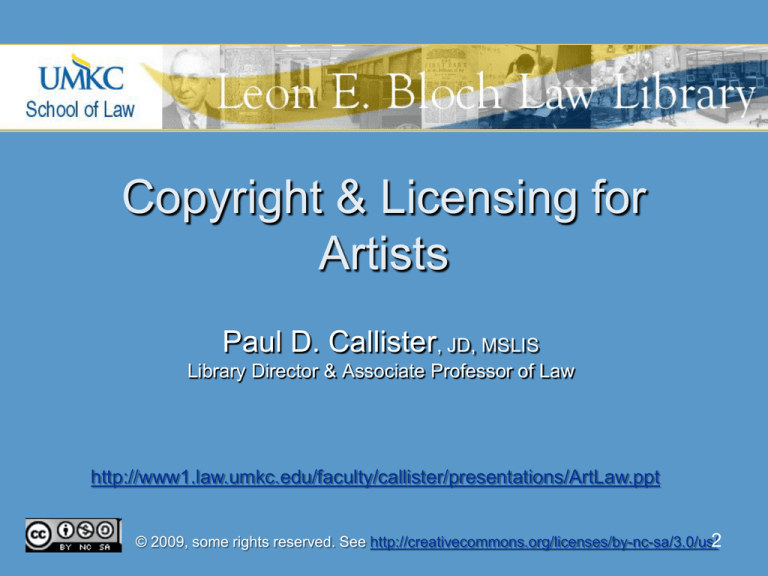
Copyright & Licensing for
Artists
Paul D. Callister, JD, MSLIS
Library Director & Associate Professor of Law
http://www1.law.umkc.edu/faculty/callister/presentations/ArtLaw.ppt
© 2009, some rights reserved. See http://creativecommons.org/licenses/by-nc-sa/3.0/us/2
THE FOLLOWING PRESENTATION IS
FOR DISCUSIONAL PURPOSES ONLY
AND SHOULD NOT BE CONSTRUED
AS OR REPLACE THE NEED FOR
OBTAINING LEGAL ADVICE.
YOU
SHOULD CONSULT AN ATTORNEY.
3
Coprightable?
• Has to be fixed in a tangible medium of expression
• Expression not the idea
• Problem for merger of expression and idea
• For photographs
o background
o lights
o shading
o positioning
o timing
• For photographs, copyright does not extend to the
subject matter
•Originality (as in being the originator) and modicum
of creativity, not novelty (don’t have to be first)
4
Umbrella Project1991 10 27.jpg
1991 Umbrella Project(Japan) : Christo und
Jeanne-Claude, photo by DDdeco
Permission is granted to copy, distribute and/or modify this document under the
terms of the GNU Free Documentation License, Version 1.2 or any later version
published by the Free Software Foundation; with no Invariant Sections, no FrontCover Texts, and no Back-Cover Texts. A copy of the license is included in the
section entitled "GNU Free Documentation License"
5
See Gentieu v. Muller & Co., 712 F.Supp 740 (W.D. Mo. 1989) (“not expanded on idea
of photograph, . . . Limited to copying . . . her work”); Getty. Gentieu v. Tony Stone
Images/Chicago Inc. et al, 255 F. Supp. 2d 838 (N.D. Ill, 2003); Photo Lawyer,
Gentieu Litigation Shows Brute Force of the Courts, Feb 28, 2007, at
6
http://nylawline.typepad.com/photolawyer/2007/02/gentieu_litigat.html .
Save Planet Earth, by V2
See Mead v. United States, 27 F. Cl. 367 (Fed. Cl.
1992) (an idea not an expression).
Creative Commons License 3.0
7
W.W. Denslow, Wizard of Oz
See Hearn v. Meyer, 644 F.Supp. 832 (S.D.N.Y. 1987)
(Reproduction of Reproduction: Mere insignificant variations
in coloration not alleged to be created intentionally, “mere
8
slavish copies” ). Media file in the public domain.
Derivative &
Transformative Works
9
Rogers v. Koons, 960 F.2d 301
C.A.2 (N.Y.),1992
Another Link
10
Blanch v. Koons, 467 F.3d 244,
C.A.2 (N.Y.), 2006
11
AP (Mannie Garcia)
v. Shepard Fairey
12
Gaylord v. U.S.
85 Fed. Claims Ct. 59 (2008)
13
14
Attribution: Tracy Lee Carroll (aka StarrGazr ), Korean War Memorial,
15
at http://www.flickr.com/photos/tracylee/137006271/ .
http://creativecommons.org/licenses/by-nc-nd/2.0/deed.en
The Law
16
U.S. Constitution Art. I, Sect. 8, Cl. 8
17
The Rights in Copyright
17 U.S. Code § 106
The owner of copyright . . . has the exclusive rights to do and to
authorize any of the following:
(1) to reproduce the copyrighted work in copies or phonorecords;
(2) to prepare derivative works based upon the copyrighted work;
(3) to distribute copies . . . of the copyrighted work to the public . . . ;
(4) in the case of literary, musical, dramatic . . . and motion pictures
and other audiovisual works, to perform the copyrighted work publicly;
(5) in the case of literary, musical, dramatic . . . pictorial, graphic, or
sculptural works, including the individual images of a motion picture or
other audiovisual work, to display the copyrighted work publicly; and
(6) in the case of sound recordings, to perform the copyrighted work
publicly by means of a digital audio transmission.
18
The Law – Copyright –
Exclusions and Exceptions
• Not Fixed
• Merger of Idea and Expression (limitation)
• Public Domain
– U.S. Government Documents
– Before 1923
– Other
• Permission
– Orphan Works
– Copyright Clearance Center (http://www.copyright.com/)
• First Sale
– Sell the copy you bought
– Lend the copy you bought
• Fair Use (§ 107)
• Library Exceptions (§ 108)
19
Public Domain
20
Source: Peter B. Hirtle,
Copyright Term and the
Public Domain in the United
States, 1 January 2009,
available at
http://www.copyright.cornell.
edu/resources/publicdomain
.cfm. Licensed under
Creative Commons License
3.0 at
http://creativecommons.org/l
icenses/by-nc/3.0/.
21
Fair Use
17 U.S. Code § 107
The fair use of a copyrighted work, including such use by reproduction in
copies . . . for purposes such as criticism, comment, news reporting,
teaching (including multiple copies for classroom use), scholarship, or
research, is not an infringement of copyright. In determining whether the
use made of a work in any particular case is a fair use the factors to be
considered shall include –
(1) the purpose and character of the use, including whether such use is
of a commercial nature or is for nonprofit educational purposes;
(2) the nature of the copyrighted work;
(3) the amount and substantiality of the portion used in relation to the
copyrighted work as a whole; and
(4) the effect of the use upon the potential market for or value of the
copyrighted work.
22
Penalties
17 U.S. Code § 504 (c) (Civil Penalty)
(1) The copyright owner may elect, at any time before final judgment is
rendered, to recover. . . a sum of not less than $ 750 or more than $
30,000 as the court considers just.
(2) In a case where the copyright owner sustains the burden of
proving, and the court finds, that infringement was committed willfully,
the court in its discretion may increase the award of statutory damages
to a sum of not more than $ 150,000.
18 U.S. Code § 2319 (Criminal)
(b) Any person who commits an offense under section 506(a)(1)(A) of
title 17 -(1) shall be imprisoned not more than 5 years, or fined in the amount
set forth in this title, or both, if the offense consists of the reproduction or
distribution, including by electronic means, during any 180-day period, of
at least 10 copies . . . which have a total retail value of more than $
2,500 . . . .
23
Orphan Works
24
Uploaded by Bob
Bobster to flickr from
25
Library of Congress
Source: Peter B. Hirtle,
Copyright Term and the
Public Domain in the United
States, 1 January 2009,
available at
http://www.copyright.cornell.
edu/resources/publicdomain
.cfm. Licensed under
Creative Commons License
3.0 at
http://creativecommons.org/l
icenses/by-nc/3.0/.
26
Orphan works
From Wikipedia, the free encyclopedia
Jump to: navigation, search
An orphan work is a copyright work where it is difficult or
impossible to contact the copyright holder. This situation can
arise for many reasons. The author could have never been
publicly known because the work was published
anonymously or the work may have never been traditionally
published at all. The identity of the author could have been
once known but the information lost over time. Even if the
author is known, it may not be possible to determine who
inherited the copyright and presently owns it. Nearly any
work where a reasonable effort to locate the current
copyright owner fails can be considered orphaned. However
the designation is often used loosely and in some
jurisdictions there is no legal definition at all.
27
http://odeo.com/episodes/23547051-Against-Orphan-Work-reform
S.2913 & H.R.5889
110th Congress (2008)
• Limited damages for infringement to reasonable
compensation
• For libraries and non-profits, simply required that
institution cease infringement
• Conducted a “qualifying search” using a “diligent
effort”
H.R. 5899 (Orphan Works Act of
2009)
S.2913 (Bentley Orphan Works Act)
“Reasonable and diligent”
Search Copyright Office Records
“Best practices” as determined by
Registrar of Copyrights
Search reasonably available
resources
Timing proximate to infringement
Use appropriate technology, printed
publications and “internal or external
expert assistance.”
29
Use appropriate databases
S.2913 & H.R.5889
110th Congress (2008)
• Limited damages for infringement to reasonable
compensation
• For libraries and non-profits, simply required that
institution cease infringement
• Conducted a “qualifying search” using a “diligent
effort”
• No waiver of duty to search if no “identifying
information”
• “Notice Use” Archive
• Database of Pictorial, Graphic and Sculptural
Works
30
Sarah Glazer, Future of Books: Will Traditional Print Books Disappear, 19 CQ
RESEARCHER , MAY 29, 2009, available at CQ Research Plus Archive.
31
Charitable Deductions
for Copyrighted Works – Must be an
Undivided Interest
A deduction is allowed under section 170 for the value of a charitable
contribution not in trust of an undivided portion of a donor's entire
interest in property. An undivided portion of a donor's entire interest in
property must consist of a fraction or percentage of each and every
substantial interest or right owned by the donor in such property and
must extend over the entire term of the donor's interest in such property
and in other property into which such property is converted. . . .
Thus, for example, a deduction is not allowable for the value of an
immediate and perpetual gift not in trust of an interest in original historic
motion picture films to a charitable organization where the donor retains
the exclusive right to make reproductions of such films and to exploit
such reproductions commercially.
Treas. Reg §1.170A-7(b)(1)(i)
32
What is the Amount of the Charitable
Deduction? Cost to create or MV?
If the contributed property . . . could be sold at the time of the gift to
yield ordinary income or short-term capital gain (i.e., property held for
one year or less), then regardless of the recipient's identity, the
property's value must be reduced by the amount that would be ordinary
income or short-term gain, determined without regard to Code Sec.
1221(b)(3) , if the property had been sold for fair market value. Code
Sec. 170(e)(1)(A) . . . . The same rule applies to works of art, literary
compositions, letters, and so on, given by the creator. Reg §1.170A4(b)(1) .
Example. Mr. Artiste creates a painting at a cost to him of $50 (for
brushes, paint and canvas). He gives it to charity five years later when
its value is $1,000. His deduction is $50, because the painting is
ordinary-income property in his hands. For more examples, see Reg
§1.170A-4(d) .
RIA U.S. Tax Reporter, Explanations ¶1704.42 (2009)
33
What are the limitations on Charitable
Deductions?
See your Accountant for Details
50% of “contribution base” (AGI) unless
• certain capital asset (property used in trade or
business)
• made to certain types of charities (other than
schools, educational organizations, government)
• made by corporations
then the limitation is reduced to a lower percentage.
34
Also Note
• Penalties are big
• Need Qualified Appraisal and certain filing forms
(if based upon FMV)
35
Framework of Licensing Issues
•
•
•
•
•
•
•
Choice of Law and Forum
Rights & Obligations
Warranties & Indemnification
Price
Default & Remedies
Termination & Cure
Formation & Modification
Software License
Agreement Sticker by
John Pastor. Source:
http://www.flickr.com/ph
otos/ttkgeek/227282484
0/
‘House’ Frame by Ray
Tibbits. Source: Flickr, at
http://www.flickr.com/photo
s/aparejador/1393082783/
36
Legal Resources for Artists
• KC Volunteer Lawyers & Accountants for the Arts at
http://www.kcvlaa.org/
• University of Texas Crash Course in Copyright at
http://www.utsystem.edu/OGC/IntellectualProperty/cprtindx.htm
• Ralph Lerner, and Judith Bresler, Art Law: The Guide for Collectors,
Investors, Dealers, and Artists (3rd ed., 2005) (for local library holdings,
see http://www.worldcat.org/oclc/62207673)
• Creative Commons (source for free images and license agreements to
license your work) http://creativecommons.org/
37
The End
38


